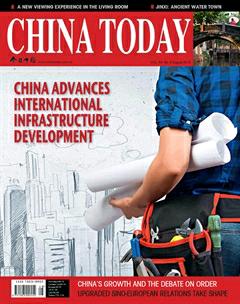Circuit Courts Promote Judicial Reform
By+staff+reporter+HOU+RUILI

CHINAs Supreme Peoples Court established last January two circuit courts, one in Shenzhen, southern Chinas pilot city for the reform and opening-up policy, and the other in the more conservative industrial city of Shenyang in Northeast China. Tasked with hearing major administrative, civil and commercial cases involving two or more administrative regions, these two circuit courts will set in motion Chinas deepened judicial reforms.
Strengthen Judicial Independence
The concept of circuit courts is not new to Chinas judicial system. There have been earlier, scattered tryouts. The recent establishment of those under the Supreme Peoples Court, however, constitutes a large scale, institutionalized measure.
Circuit courts were frequently held in revolutionary base areas during the War of Chinese Peoples Resistance Against Japanese Aggression and the Liberation War periods. Due to limited official premises, many cases were filed with and heard in situ in what were referred to as prairie, horse-back, maritime, and field courts.
In 1953, the Chinese government began its gradual establishment of circuit courts at the county level. The country revised its Civil Procedure Law in 1982 and stipulated a combined system of circuit and in situ trials. The 1991 modified provisions of the Civil Procedure Law hold that the Peoples Court can hear cases, where appropriate, on the original site at a circuit trial.
In 2006, the government proposed “a sound circuit, an expanded scope of application of simplified procedures, and convenience of litigation for the masses.”
Until 2014 a system similar to that of the circuit court, whereby certain administrative cases filed with local intermediate courts are required to be transferred to intermediate courts of other regions, and some civil cases are handled in courts whose jurisdiction spans different administrative regions, was commonplace in China. These measures embody the continuous reform of Chinas judicial system.
In October 2014, the Fourth Plenary Session of the 18th CPC Central Committee proposed optimizing judicial authority disposition, promoting pilot reforms aimed at separating judicial authority from executive authority, establishing circuit courts under the Supreme Peoples Court, exploring the establishment of courts and procuratorates with jurisdictions spanning different administrative regions, and allowing prosecutors to institute public interest.endprint
“The two circuit courts established by the Supreme Peoples Court are the first institutionalized and immobilized circuit courts since the founding of the PRC,” vice director of Lawsuit System and Judicial Reform Research Center of Renmin University of China Cheng Lei said.
The steady rise in recent years of social problems in China is manifest in the growing volume of litigations. The Supreme Peoples Court has heard more than 10,000 cases and registered 60,000 to 70,000 cases each year since 2010.
On January 1, 2007, the Supreme Peoples Court took back the power of death penalty review that had been transferred to provincial courts in 1983. This change adds to the Supreme Peoples Court the workload of at least 300 judges.
On October 28, 2007, the Standing Committee of the National Peoples Congress passed the resolution to amend the Civil Procedure Law whereby parties that dispute a verdict or ruling that has come into effect can apply for a retrial at the higher-level court.
Since the final judgment of most cases is made at the Intermediate Peoples Court or the Higher Peoples Court, retrials are therefore submitted to the Higher Peoples Court or the Supreme Peoples Court.
“An influx of cases is detrimental to the Supreme Peoples Court, the highest judicial organ, in its oversight function of guiding the work of regional courts, and also to the convenience of litigants,” Supreme Peoples Court spokesman Sun Jungong said.
The establishment of the circuit courts will relieve the pressure of death sentence reviews and retrials and reduce extrajudicial disputes.
China has 3,573 local courts at different levels, the majority of which correspond to the division of administrative regions, according to General Office Director of the Supreme Peoples Court Judicial Reform Leading Group He Xiaorong. As property is a local concern, legal matters in this connection are prey to local government influence and interference. The establishment of courts with jurisdic-tions spanning different administrative regions will fundamentally eliminate local government interference in the administration of justice and ensure impartial handling of cases involving local stakeholders.
Judges in Charge
Under the “Let the trial judge and the judge be in charge” principle, the presiding judge selected by the Supreme Peoples Court and the collegiate bench preside over cases tried in circuit courts.endprint
Fang Yongmei had been a judge in criminal trials at Nantong Intermediate Peoples Court in Jiangsu Province for more than a decade when, in December 2014, she received notification from the Supreme Peoples Court of a two-year posting in Shenyang as assistant judge in the Second Circuit Court. “This was a valuable opportunity to work with excellent Supreme Peoples Court judges,” Fang said.
Fang helps the presiding judge receive appellants. “As they are generally emotional during the one-hour interview, the presiding judge must exercise patience when listening to appellants grievances and try to calm them while giving clear explanations. All of the information about their situations is computerized,” Fang said.
Circuit courts hear four types of cases. First are administrative cases in first instance that are of significance and complexity on a national scale and civil and commercial cases in the first instance that have major impact on the country.
Second are appeals against judgments of administrative, civil or commercial cases in the first instance at the Higher Peoples Court; applications for retrials of administrative, civil or commercial cases whose rulings by the Higher Peoples Court have come into effect; criminal petition cases; and retrial cases heard by the court in performing its judicial supervision function. These cases at present account for a large proportion of the Supreme Peoples Court mandate. Putting them within the ambit of circuit courts will alleviate pressure on the Supreme Peoples Court and so be of help to clients and litigants.
Third are cases concerning procedural matters – largely appeals to reconsider decisions by the Higher Peoples Court on fines and detentions; cases the Higher Peoples Court submits to the Supreme Peoples Court for rulings or decisions due to restraints on the formers jurisdiction; and appeals to the Higher Peoples Court to extend case time limits.
Fourth are civil and commercial cases and judicial assistance cases involving parties from Hong Kong, Macao, and Taiwan, so making lawsuits convenient for residents of these regions.
The Shenzhen circuit court can also accept and judge such above-mentioned cases in Guangdong and Hainan provinces and Guangxi Zhuang Autonomous Region. The Shenyang circuit court covers Liaoning, Jilin, and Heilongjiang provinces.
“The location choice of the circuit courts is closely related to local economic and social development as well as the work of judicial adjudication,” Sun Jungong said.endprint
Establishing the First Circuit Court in Shenzhen is mainly due to Guangdongs rapid economic development and consequently large volume of cases. Also, as the SEZ is close to Hong Kong and Macao, it handles a wide range of cases. Establishing a circuit court here, therefore, will help to unify applicable legal standards.
Locating the Second Circuit Court in Shenyang is attributable to Northeast Chinas historical industrial bases, where disputes under the context of economic restructuring and industrial upgrading are steadily growing. The Second Circuit Court will promote development of these old industrial bases in both economic and social spheres.
Sun believes that the Supreme Peoples Court will add new circuit courts in the future, and timely adjust the regions and scope of cases they deal with according to conditions.
The circuit court is expected to reach verdicts in situ as far as possible, which is a big challenge to judges, according to Yu Zhengping, vice president of the Second Circuit Court.
“This mode of judgment is of benefit to society as a whole, and also tests the traditional judicial case-handling mechanism and running mode,” Yu said.
Prevent Judicial Corruption
In addition to installing an Ombudsman-like position for day-to-day supervision of the circuit court, the circuit courts have also imposed on their staff a lifelong accountability system that entails investigations into misjudged cases. Presiding judges are selected by the Supreme Peoples Court, and serve two-year tenures to inhibit the forming of local interest relationships.
Circuit court cases are consolidated into the Supreme Peoples Courts trial information integrated management platform. Registration information, trial procedures, and judgment documents are accessible to concerned parties and open to social supervision.
Moreover, the Supreme Peoples Court discipline inspection and supervision department will supervise the work of circuit courts, and an online complaints and report platform will strengthen related judicial inspection and trial supervision.
“Promoting justice through openness and social supervision will maximally lower peoples misgivings about judicial fairness,” Yu said. “All trial details are open to the public and can be exposed. As regards procedures, more reforms are forthcoming.”
The judicial work of the Second Circuit Court will be more open than that of the Supreme Peoples Court headquarters, according to president of the Second Circuit Court Hu Yunteng. Judgment documents and related rules and regulations will be put online, so allowing the public to ensure justice.
The goal of judicial reform is to resolve social disputes through judicial channels according to the rule of law. In this context, the circuit court is an effective judicial reform measure.endprint

